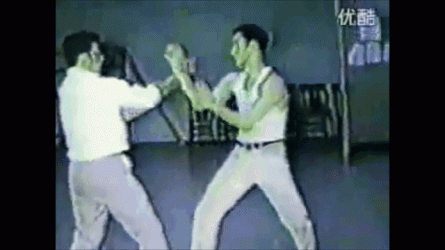IMO, the arm drag and switch hands are similar, but the starting point are different. What's your though on this?
In this clip, his starts from his right arm deals with his opponent's right arm. He was using "switch hands" without the wrist pulling.
View attachment 26856In chi-sauI
One thought is that, as you said, "the starting points are different."
In the Bruce Lee clip from
Enter the Dragon, Lee and Bob Wall (playing O'hara) are
starting at a longer, "semi-detached" range with only one hand touching. Lee explodes forward using a left
pak-sau to free his right lead which springs forward and pops Wall in the nose. This type of "switch hands" as you call it is basic to WC. I prefer to see it as "freeing the attacking hand to thrust forward" so we can follow our motto
"...lat sau jik chung."
In
chi-sau, you are
closer to your partner, both hands are touching, and
either hand can hit directly if freed ...so each hand must control the hand it is in contact with, or else you must use
one hand to control two before you try to release your "stick". So, to enter inside with
a left
pak-sau and right punch, for example, I prefer to step in close with my
pak-sau so that my forearm functions as a
lan-sau controlling both my opponent's arms with one of my arms. So... better than just "switch hands", I have control of two with one, freeing the other to strike.
In the video below, go to
1:05 - 1:18, slowed to
0.5 speed to see something similar to the inside pak-sau attack in chi-sau I described above. Notice how the attacker's forearm acts like a
lan-sau to pin and control his opponent's rear arm as he executes his
pak-da attack.
Inside Pak-da from Chi-Sau:
Yesterday when I was playing with arm-drags in
chi-sau, I was very aware of the need to "control two hands with one" ...so we initiated the arm-drag attack much like the inside gate
pak-da described above, using except instead of applying a
pak, I initiated with a low, left punch, then my left hand moved across (like the
pak-sau in the video) and caught my opponent's left arm behind the elbow ...as my right circled and caught his left wrist for an instantaneous "switch hands" trade off (no hanging out in the two arms on-on one position) leading to a quick snap-across arm-drag and enter via the side-gate. Complicated to describe, not so complicated to do.
As above, my left forearm momentarily functioned as a
lan-sau pinning and controlling my opponent's left. This gave me the instant of control I needed to safely execute the move at the closer
chi-sau range.
The real question is
why? That is why would you choose to attempt a potentially risky arm-drag rather than the "bread and butter" inside
pak-da? This is a question we discussed at training. What we came up with is this. Inside
pak-da is a very effective
chi-sau attack. Often you can score at least one or two easy hits if you know how to apply it. Then... it can get messy. In sparring you end up trading punches. Sorta like the "milling" done by young British recruits. Great for training aggression, determination, and "grit" in troops. Not so much for skill in
chi-sau.
Milling:
The advantage of a move like the
modified arm-drag described above is that it puts you to the outside and potentially even behind your opponent. Now that's a far better place to be to follow up your initial attack and finish the job
...without just trading punches. 
